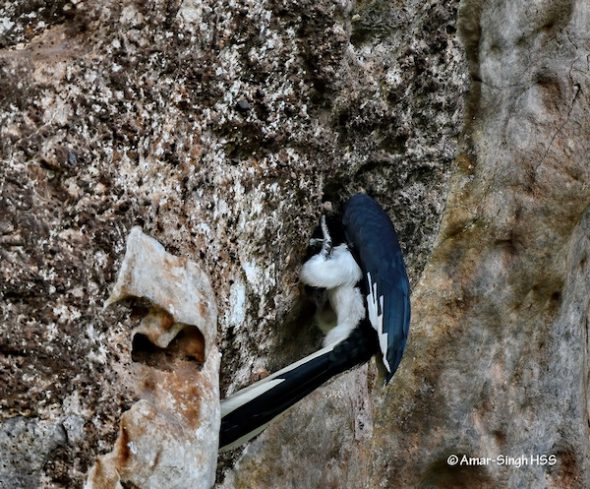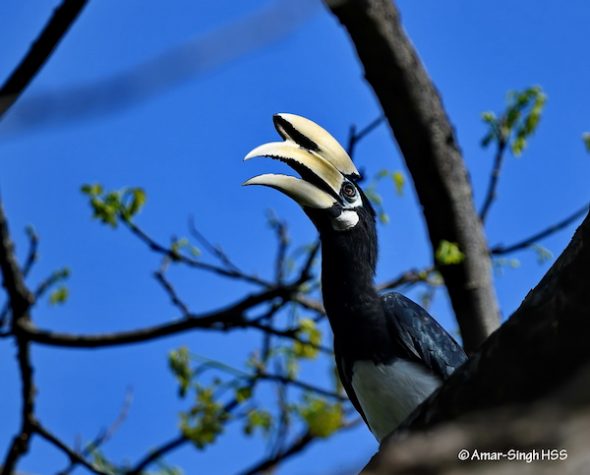I was watching Banded Bay Cuckoos and recording their calls when I heard two Oriental Pied Hornbills (Anthracoceros albirostris convexus) calling out. I spotted a male calling out loudly with responsive calls coming from a female. The female then flew to the adjacent limestone outcropping and proceeded to regurgitate food into a cavity located 6-7 meters up. I was not surprised at a nesting site in limestone as my bird watching colleague and friend Connie Khoo alerted me to this possibility in our city some years back (Khoo 2017). In literature they are noted to nest ‘rarely in limestone cliff’ (Kemp & Boesman 2020). One reason for using limestone cavities could be that the city has lost a huge number of old trees by extensive mal-development and misguided city council replanting with shrubs and palms. This has reduced old tree nesting sites for Hornbills (and woodpeckers). Note that locally there have also been reports of Oriental Pied Hornbill nesting in huge earthen jars placed sideways on the ground (jars locally known as ‘tempayan’).

Post 1. The female at the limestone cavity.
I was also not totally surprised by a female Oriental Pied Hornbill regurgitating food into a cavity as I had observed a similar episode in Sabah in 2017 (Amar-Singh HSS 2017). Whether this is co-operative breeding requires more observation. Oriental Pied Hornbills in literature are said to be monogamous and breed as separate pairs without helpers (Kemp 1995).
Disclosure:
At this point I would like to make a disclosure about watching this ‘nest’. The behaviour and nesting cavity was spotted by chance as I was watching other birds. I did not approach the site or stay to pursue observations as this location has some risks to the birds. New development is going on 300 meters away and individuals pass the site occasionally. I did not want to alert anyone to the Hornbill’s presence as illegal poaching of hornbills is still a problem. I hope to find a distant vantage point to do follow up observations.

Post 2. The female at the limestone cavity.
As I have discussed previously co-operative breeding (helpers) has yet to be described in Oriental Pied Hornbills. Kinnaird & O’Brien (2007) summarise observations and provide a list of hornbills known to practice co-operative breeding report – 9 Asian and 4 African species. For my region only the Bushy-crested Hornbill (Anorrhinus galeritus) and the White-crowned Hornbill (Berenicornis comatus) have been documented to practice co-operative breeding.
I would also like to keep in view that this could be some form of courtship behaviour; a ritual that encourages mating or showing a desire to start another round of nesting. The regurgitation of feeds and visit to a nesting hole could be a courtship behaviour that cements a bond between the pair.
Opinions welcome.

Post 3. The male calling out.
References:
- Connie Khoo (2017). Oriental Pied Hornbills Nest Moving? Singapore Bird Group. Available here: https://singaporebirdgroup.wordpress.com/2017/07/03/oriental-pied-hornbills-nest-moving/ (note also comments by Alan Kemp).
- Amar-Singh HSS (2017). Oriental Pied Hornbill – possible co-operative breeding. Bird Ecology Study Group. Available here: https://besgroup.org/2017/05/18/oriental-pied-hornbill-possible-co-operative-breeding/
- Margaret F. Kinnaird, Timothy G. O’Brien (2007). The Ecology and Conservation of Asian Hornbills: Farmers of the Forest. University of Chicago Press.
- Alan Kemp (1995). The Hornbills: Bucerotiformes (Bird Families of the World). Oxford University Press, USA.
- Kemp, A.C. and P. F. D. Boesman (2020). Oriental Pied-Hornbill (Anthracoceros albirostris), version 1.0. In Birds of the World (J. del Hoyo, A. Elliott, J. Sargatal, D. A. Christie, and E. de Juana, Editors). Cornell Lab of Ornithology.
Amar-Singh HSS (Dato’ Dr) – Ipoh, Perak, Malaysia
Location: Ipoh, Perak, Malaysia
Habitat: Semi-urban. Limestone outcropping at fringe of the city
Date: 3rd September 2020
Equipment: Equipment: Nikon D500 SLR with Nikon AF-S Nikkor 500mm f/5.6E PF ED VR, handheld with Rode VideoMic Pro Plus Shotgun Microphone








